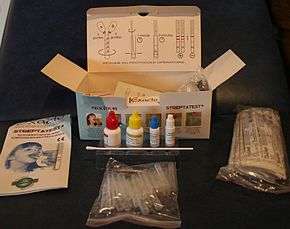Rapid diagnostic test
A rapid diagnostic test (RDT) is a medical diagnostic test that is quick and easy to perform. RDTs are suitable for preliminary or emergency medical screening and for use in medical facilities with limited resources. They also allow point-of-care testing in primary care for things that formerly only a laboratory test could measure. They provide same-day results within two hours, typically in approximately 20 minutes.[1][2]

The European Union defines that a rapid test means qualitative or semi-quantitative in vitro-diagnostic medical devices, used singly or in a small series, which involve non-automated procedures and have been designed to give a fast result.[3]
Lateral flow tests are probably the most known type of rapid diagnostic tests[4], similar to pregnancy tests, but there exist other systems as dipsticks, vertical flow, etc. Anything that can be used at bedside (Point-of-care) of the patient.
Examples
Some examples of RDTs are listed below:
See also
References
- "Simple / Rapid tests". WHO. Retrieved 19 July 2014.
- "Rapid Diagnostic Tests: How They Work". CDC. Retrieved 19 July 2014.
- 2009/886/EC: Commission Decision of 27 November 2009 amending Decision 2002/364/EC on common technical specifications for in vitro diagnostic medical devices
- Quesada-González, Daniel; Merkoçi, Arben (2015). "Nanoparticle-based lateral flow biosensors". Biosensors & Bioelectronics. 15 (special): 47–63. doi:10.1016/j.bios.2015.05.050. hdl:10261/131760. PMID 26043315.